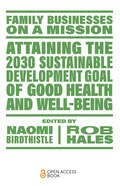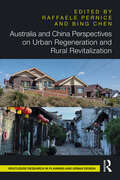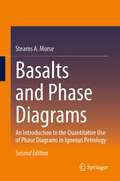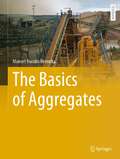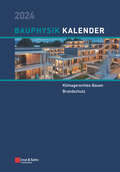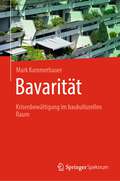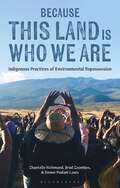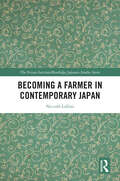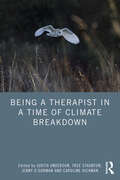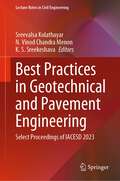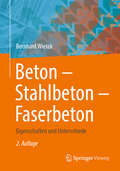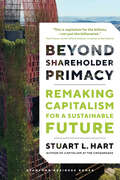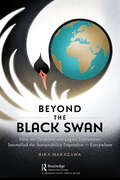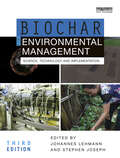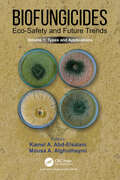- Table View
- List View
Attaining the 2030 Sustainable Development Goal of Gender Equality (Family Businesses on a Mission)
by Naomi Birdthistle Rob HalesThe ebook edition of this title is Open Access and freely available to read online. Attaining the 2030 Sustainable Development Goal of Gender Equality focuses on Sustainable Development Goal number five (SDG#5): ending all forms of discrimination against women and girls. Examining family businesses in Honduras, Australia, Austria, and Lebanon, each case study presents a unique perspective from their respective country, analysing how SDG#5 translates into empowering women and girls around the world. The case studies presented generate insights and key takeaways into the role of family businesses in eliminating violence and other harmful practices as well as ensuring equal opportunities and participation for women in business and beyond. The United Nations’ (UN) Sustainable Development Goals (SDGs) are 17 Goals pledged by 193 nations in 2015 which would help engender an improved, fairer, and more sustainable world – one in which ‘no one is left behind’. The SDGs are a call to action, to develop innovative solutions to the most complex, societal, and environmental global challenges. In Family Businesses on a Mission, series editors Naomi Birdthistle and Rob Hales bring together international case studies to illustrate how family businesses can attain the UN 2030 SDGs. Accessible to those working in the field beyond academia – such as family business practitioners, family business owners, government and policymakers, members of NGOs, business associations and philanthropic centres – this book series equally appeals to those with a general interest in entrepreneurship and business.
Attaining the 2030 Sustainable Development Goal of Good Health and Well-Being (Family Businesses on a Mission)
by NAOMI BIRDTHISTLE AND ROB HALESThe ebook edition of this title is Open Access and freely available to read online. Attaining the 2030 Sustainable Development Goal of Good Health and Well-Being focuses on Sustainable Development Goal number three (SDG#3): prioritising the emotional and physical health of humans around the world. Examining family businesses in Germany, Malaysia, Mexico, and Australia, each case study presents a unique perspective from their respective country, analysing how SDG#3 translates into ensuring healthy lives and promoting well-being for all. The case studies presented generate insights and key takeaways into the role of family businesses in fostering safety and equality in healthcare systems and infrastructure across the globe. The United Nations’ (UN) Sustainable Development Goals (SDGs) are 17 Goals pledged by 193 nations in 2015 which would help engender an improved, fairer, and more sustainable world – one in which ‘no one is left behind’. The SDGs are a call to action, to develop innovative solutions to the most complex, societal, and environmental global challenges. In Family Businesses on a Mission, series editors Naomi Birdthistle and Rob Hales bring together international case studies to illustrate how family businesses can attain the UN 2030 SDGs. Accessible to those working in the field beyond academia – such as family business practitioners, family business owners, government and policymakers, members of NGOs, business associations and philanthropic centres – this book series equally appeals to those with a general interest in entrepreneurship and business.
Attaining the 2030 Sustainable Development Goal of Good Health and Well-Being (Family Businesses on a Mission)
by Naomi Birdthistle Rob HalesThe ebook edition of this title is Open Access and freely available to read online. Attaining the 2030 Sustainable Development Goal of Good Health and Well-Being focuses on Sustainable Development Goal number three (SDG#3): prioritising the emotional and physical health of humans around the world. Examining family businesses in Germany, Malaysia, Mexico, and Australia, each case study presents a unique perspective from their respective country, analysing how SDG#3 translates into ensuring healthy lives and promoting well-being for all. The case studies presented generate insights and key takeaways into the role of family businesses in fostering safety and equality in healthcare systems and infrastructure across the globe. The United Nations’ (UN) Sustainable Development Goals (SDGs) are 17 Goals pledged by 193 nations in 2015 which would help engender an improved, fairer, and more sustainable world – one in which ‘no one is left behind’. The SDGs are a call to action, to develop innovative solutions to the most complex, societal, and environmental global challenges. In Family Businesses on a Mission, series editors Naomi Birdthistle and Rob Hales bring together international case studies to illustrate how family businesses can attain the UN 2030 SDGs. Accessible to those working in the field beyond academia – such as family business practitioners, family business owners, government and policymakers, members of NGOs, business associations and philanthropic centres – this book series equally appeals to those with a general interest in entrepreneurship and business.
Australia and China Perspectives on Urban Regeneration and Rural Revitalization (Routledge Research in Planning and Urban Design)
by Raffaele Pernice Bing ChenThis edited volume reviews important contemporary issues through relevant case studies and research in China and Australia, such as the challenges posed by climate change, the development of eco-urban design, research on sustainable habitats and the relationship between ecology, green architecture and city regeneration, as well as, in general, the future of the city in the new millennium.The authors represent a broad selection of international experts, young scholars and established academics who discuss themes related to urban–rural destruction and economic and spatial regeneration techniques, the sustainable reconversion of natural landscapes and eco-urban design in the context of the current evolution of architectural and urbanism practice. The book aims to explain the conditions in which the contemporary debate about urban regeneration and rural revitalisation has developed in Australia and China, presented by different theoretical and methodological perspectives. It also provides a multifaceted and critical analysis of relevant case studies and urban experiences in Australia and China, focusing on environmental disruption, resized urban interventions and the need for more efficient and sustainable forms of regeneration and urban renewal practice in urban–rural contexts.This book will be an invaluable resource for architects, planners, architectural and urban historians, geographers, and scholars interested in modern Australian and Chinese architecture and urbanism.
Australia and China Perspectives on Urban Regeneration and Rural Revitalization (Routledge Research in Planning and Urban Design)
This edited volume reviews important contemporary issues through relevant case studies and research in China and Australia, such as the challenges posed by climate change, the development of eco-urban design, research on sustainable habitats and the relationship between ecology, green architecture and city regeneration, as well as, in general, the future of the city in the new millennium.The authors represent a broad selection of international experts, young scholars and established academics who discuss themes related to urban–rural destruction and economic and spatial regeneration techniques, the sustainable reconversion of natural landscapes and eco-urban design in the context of the current evolution of architectural and urbanism practice. The book aims to explain the conditions in which the contemporary debate about urban regeneration and rural revitalisation has developed in Australia and China, presented by different theoretical and methodological perspectives. It also provides a multifaceted and critical analysis of relevant case studies and urban experiences in Australia and China, focusing on environmental disruption, resized urban interventions and the need for more efficient and sustainable forms of regeneration and urban renewal practice in urban–rural contexts.This book will be an invaluable resource for architects, planners, architectural and urban historians, geographers, and scholars interested in modern Australian and Chinese architecture and urbanism.
Basalts and Phase Diagrams: An Introduction to the Quantitative Use of Phase Diagrams in Igneous Petrology
by Stearns A. MorseIn this newly revised and expanded edition the reader finds both an introduction to igneous petrology and an exposition of the quantitative use of phase diagrams in understanding the origin and crystallization history of basic magmas. The book provides a step-by- step analysis of crystallization and melting in a limited number of geologically significant phase diagrams. The limiting processes of fractional and equilibrium melting and fractional and equilibrium crystallization are rigorously examined. Examples of the use of phase diagrams are drawn from the literature of layered intrusions, redox equilibria in iron-bearing systems, and the high pressure equilibria of melting in the mantle.
The Basics of Aggregates (Springer Textbooks in Earth Sciences, Geography and Environment)
by Manuel Bustillo RevueltaAggregates are among the most common natural resource used in everyday's life, having enhanced life quality. They are essential for construction, being utilized in nearly all residential, commercial, and industrial building construction and most public work projects such as roads, highways and bridges, railroad beds, dams, airports, tunnels, and many others. In the future, the rebuilding of deteriorated roads, highways, bridges, airports, seaports, and private and public buildings will require vast amounts of aggregate. Although it is almost impracticable to know the total amount of aggregates extracted every year globally, it is roughly estimated that annual aggregate production totals about 25 billion tons. Both developed and developing nations require extensive use of aggregates.The book "The Basics of Aggregates" covers all topics related to utilizing this type of material, including the properties of aggregates, types of deposits, geological occurrence, exploration methodologies and extraction methods, and processing techniques as well as their main applications and the importance of recycled aggregates. It serves as a basic text on aggregates for natural sciences and provides information about the main aggregate materials comprehensively with extensive number of illustrations and equips students to handle the mining cycle of aggregates. It enhances the understanding of the different aggregate types, being interdisciplinary and practice-oriented. This textbook addresses bachelor and master students of geology and general earth science as well as students of engineering and environmental sciences. It is written for undergraduate and graduate students, researches and professionals alike.
Bauphysik-Kalender 2024: Schwerpunkte: Klimagerechtes Bauen; Brandschutz (Bauphysik-Kalender-eBundle (Ernst & Sohn))
by Nabil A. FouadDer Bauphysik-Kalender 2024 gibt Praxishinweise für die klimagerechte Planung von Gebäuden, aber auch von urbanen Räumen. Diese sind durch die hohen Verdichtungen und Versiegelungen besonders anfällig gegenüber der Klimaveränderung mit häufigeren Extremwetterereignissen. Aber sie sind gestaltbare Orte, an denen durch eine interdisziplinäre und zukunftsorientierte Planung eine weitere Verschärfung des Klimawandels gebremst und die Resilienz von Mensch, Flora und Fauna gegenüber seinen Folgen gestärkt werden kann. Das Buch bietet aktuelles Wissen um bauphysikalische Prozesse zu verstehen, Potenziale von Konstruktionen gezielt auszuschöpfen und die Gebäudetechnik und Automatisierung funktional zu halten. Außerdem werden Tools und Nachweisverfahren getestet und kommentiert, mit deren Hilfe Bilanzen über die Umweltwirkungen von Gebäuden bzw. Bewertungen der Klimaanpassung von Gebäuden ermittelt werden können. Der zweite diesjährige Schwerpunkt Brandschutz widmet sich der Holzbauweise sowie der Untersuchung von Brandeinwirkungen durch E-Fahrzeuge und kraftstoffbetriebene Fahrzeuge in Parkgaragen. Der Bauphysik-Kalender 2024 bietet eine solide Arbeitsgrundlage und ein verlässliches aktuelles Nachschlagewerk für die Planung in Neubau und Bestand, alle Kapitel bewegen sich nahe an der Ingenieurpraxis. Das Buch enthält Planungshinweise, Konzepte und Praxisbeispiele.
Bauphysik-Kalender 2024: Schwerpunkte: Klimagerechtes Bauen; Brandschutz (Bauphysik-Kalender-eBundle (Ernst & Sohn))
by Nabil A. FouadDer Bauphysik-Kalender 2024 gibt Praxishinweise für die klimagerechte Planung von Gebäuden, aber auch von urbanen Räumen. Diese sind durch die hohen Verdichtungen und Versiegelungen besonders anfällig gegenüber der Klimaveränderung mit häufigeren Extremwetterereignissen. Aber sie sind gestaltbare Orte, an denen durch eine interdisziplinäre und zukunftsorientierte Planung eine weitere Verschärfung des Klimawandels gebremst und die Resilienz von Mensch, Flora und Fauna gegenüber seinen Folgen gestärkt werden kann. Das Buch bietet aktuelles Wissen um bauphysikalische Prozesse zu verstehen, Potenziale von Konstruktionen gezielt auszuschöpfen und die Gebäudetechnik und Automatisierung funktional zu halten. Außerdem werden Tools und Nachweisverfahren getestet und kommentiert, mit deren Hilfe Bilanzen über die Umweltwirkungen von Gebäuden bzw. Bewertungen der Klimaanpassung von Gebäuden ermittelt werden können. Der zweite diesjährige Schwerpunkt Brandschutz widmet sich der Holzbauweise sowie der Untersuchung von Brandeinwirkungen durch E-Fahrzeuge und kraftstoffbetriebene Fahrzeuge in Parkgaragen. Der Bauphysik-Kalender 2024 bietet eine solide Arbeitsgrundlage und ein verlässliches aktuelles Nachschlagewerk für die Planung in Neubau und Bestand, alle Kapitel bewegen sich nahe an der Ingenieurpraxis. Das Buch enthält Planungshinweise, Konzepte und Praxisbeispiele.
Bavarität: Krisenbewältigung im baukulturellen Raum
by Mark KammerbauerDas Buch befasst sich mit der Architektur, dem Städtebau und der Stadtplanung im Freistaat Bayern aus interdisziplinärer, urbanistischer Sicht. Damit verbundene baukulturelle Partizipation kann zur Bewältigung von Krisen beitragen, wenn sowohl Akteure der Planung und Gestaltung als auch der Nutzung berücksichtigt werden. Ziel des Buches ist, den gebauten Raum Bayerns zu lesen und zu verstehen, ihn einer Kritik zu unterziehen, dabei die Erfolge nicht auszublenden, um Lösungen zu präsentieren und um schließlich Raum für die Reflexion und das Imaginieren zu "bauen". Wenn Menschen die gebaute Umwelt lesen und verstehen, dann informiert das auch ihr Handeln, insbesondere, wenn sie partizipativ an Planungs- und Gestaltungsprozessen für die Errichtung des gebauten Raums beteiligt sind. Um diese Phänomene ihrem Kontext entsprechend zu fassen und zu deuten, schlägt das Buch den Begriff der Bavarität vor. Im Fall des Freistaats Bayern und seines ländlich-städtischen Kontinuums als Ergebnis historischer baulich-räumlicher Entwicklung, durch Tradition und Moderne konturiert, stellt Bavarität eine sozio-kulturelle Leistung dar, deren Ergebnis in der Partizipation aller Beteiligten gründet und nicht endet.
Because This Land is Who We Are: Indigenous Practices of Environmental Repossession
by Chantelle RichmondBecause This Land Is Who We Are is an exploration of environmental repossession, told through a collaborative case study approach, and engaging with Indigenous communities in Canada (Anishinaabe), Hawai'i (Kanaka Maoli) and Aotearoa (Maori). The co-authors are all Indigenous scholars, community leaders and activists who are actively engaged in the movements underway in these locations, and able to describe the unique and common strategies of repossession practices taking place in each community. This open access book celebrates Indigenous ways of knowing, relating to and honouring the land, and the authors' contributions emphasize the efforts taking place in their own Indigenous land. Through engagement with these varying cultural imperatives, the wider goal of Because This Land Is Who We Are is to broaden both theoretical and applied concepts of environmental repossession, and to empower any Indigenous community around the world which is struggling to assert its rights to land.The ebook editions of this book are available open access under a CC BY-NC-ND 4.0 licence on bloomsburycollections.com. Open access was funded by Knowledge Unlatched.
Becoming a Farmer in Contemporary Japan (Nissan Institute/Routledge Japanese Studies)
by Niccolò LolliniBased on ethnographic fieldwork conducted in an agricultural cooperative running a training programme for aspiring farmers, this book explores the possibilities of agrarian and land-based modes of livelihood in contemporary Japan. The book is organised around the four key hurdles faced by new agricultural entrants: the acquisition of land and housing, farming know-how, capital, and market outlets. New farmers look with fresh eyes at agricultural issues, and their experiences provide a vantage point over the institutions shaping rural and agricultural life. The book documents the mounting problem of land and house abandonment in regional Japan, the role of agriculture in the revitalisation of rural communities, and the transformation of Japan’s agrifood system. To avoid reinforcing Japan’s exceptionalism, agricultural policy, farming practices, and fresh food distribution are analysed from a comparative perspective, shedding new light on processes of agrarian change in developed market economies. Providing an in-depth insight into pro-rural migration in the face of Japan’s shrinking regions and its declining agricultural sector, this book will be a valuable resource for students and scholars of Japanese society, agrarian policy, and rural sociology.
Becoming a Farmer in Contemporary Japan (Nissan Institute/Routledge Japanese Studies)
by Niccolò LolliniBased on ethnographic fieldwork conducted in an agricultural cooperative running a training programme for aspiring farmers, this book explores the possibilities of agrarian and land-based modes of livelihood in contemporary Japan. The book is organised around the four key hurdles faced by new agricultural entrants: the acquisition of land and housing, farming know-how, capital, and market outlets. New farmers look with fresh eyes at agricultural issues, and their experiences provide a vantage point over the institutions shaping rural and agricultural life. The book documents the mounting problem of land and house abandonment in regional Japan, the role of agriculture in the revitalisation of rural communities, and the transformation of Japan’s agrifood system. To avoid reinforcing Japan’s exceptionalism, agricultural policy, farming practices, and fresh food distribution are analysed from a comparative perspective, shedding new light on processes of agrarian change in developed market economies. Providing an in-depth insight into pro-rural migration in the face of Japan’s shrinking regions and its declining agricultural sector, this book will be a valuable resource for students and scholars of Japanese society, agrarian policy, and rural sociology.
Being a Therapist in a Time of Climate Breakdown
by Judith Anderson Tree Staunton Jenny O’Gorman Caroline HickmanThis book introduces readers to the known psychological aspects of climate change as a pressing global concern and explores how they are relevant to current and future clinical practice.Arguing that it is vital for ecological concerns to enter the therapy room, this book calls for change from regulatory bodies, training institutes and individual practitioners. The book includes original thinking and research by practitioners from a range of perspectives, including psychodynamic, eco-systemic and integrative. It considers how our different modalities and ways of working need to be adapted to be applicable to the ecological crises. It includes Voices from people who are not practitioners about their experience including how they see the role of therapy. Chapters deal with topics from climate science, including the emotional and mental health impacts of climate breakdown, professional ethics and wider systemic understandings of current therapeutic approaches. Also discussed are the practice-based implications of becoming a climate-aware therapist, eco-psychosocial approaches and the inextricable links between the climate crises and racism, colonialism and social injustice. Being a Therapist in a Time of Climate Breakdown will enable therapists and mental health professionals across a range of modalities to engage with their own thoughts and feelings about climate breakdown and consider how it both changes and reinforces aspects of their therapeutic work.
Being a Therapist in a Time of Climate Breakdown
This book introduces readers to the known psychological aspects of climate change as a pressing global concern and explores how they are relevant to current and future clinical practice.Arguing that it is vital for ecological concerns to enter the therapy room, this book calls for change from regulatory bodies, training institutes and individual practitioners. The book includes original thinking and research by practitioners from a range of perspectives, including psychodynamic, eco-systemic and integrative. It considers how our different modalities and ways of working need to be adapted to be applicable to the ecological crises. It includes Voices from people who are not practitioners about their experience including how they see the role of therapy. Chapters deal with topics from climate science, including the emotional and mental health impacts of climate breakdown, professional ethics and wider systemic understandings of current therapeutic approaches. Also discussed are the practice-based implications of becoming a climate-aware therapist, eco-psychosocial approaches and the inextricable links between the climate crises and racism, colonialism and social injustice. Being a Therapist in a Time of Climate Breakdown will enable therapists and mental health professionals across a range of modalities to engage with their own thoughts and feelings about climate breakdown and consider how it both changes and reinforces aspects of their therapeutic work.
Best Practices in Geotechnical and Pavement Engineering: Select Proceedings of IACESD 2023 (Lecture Notes in Civil Engineering #449)
by Sreevalsa Kolathayar N. Vinod Chandra Menon K. S. SreekeshavaThis book presents select proceedings of the International Conference on Interdisciplinary Approaches in Civil Engineering for Sustainable Development (IACESD 2023). The topics covered include emerging practices in geotechnical engineering and pavement, innovative approaches, and technologies to enhance the durability, sustainability, and performance of infrastructure, geosynthetics, geotechnical monitoring systems, and ground improvement techniques to address soil stability, settlement, and liquefaction issues. This book is useful for researchers and professionals’ geotechnical engineering.
Beton – Stahlbeton – Faserbeton: Eigenschaften und Unterschiede
by Bernhard WietekBeton, Stahlbeton und Faserbeton sind Baustoffe, die nacheinander in großen Zeitabständen entwickelt wurden. Auf Grund ihrer unterschiedlichen Zusammensetzung haben sie voneinander sehr abweichende Eigenschaften, die bei jeder Anwendung auch berücksichtigt werden sollten. Diese müssen beobachtet und auch messtechnisch festgehalten werden, denn sie entscheiden über die Gebrauchszeit eines Bauwerkes. Gerade durch unterschiedliche Formen und auch Umwelteinflüsse wird diese Gebrauchszeit sehr stark beeinflusst. Es wird in einer abschließenden Tabelle dieser Zusammenhang aufgezeigt.
Beyond Shareholder Primacy: Remaking Capitalism for a Sustainable Future
by Stuart HartFrom the author of Capitalism at the Crossroads, a call to consciousness—and action—for individuals, organizations, communities, and nations. Our current Milton Friedman–style "shareholder primacy capitalism," as taught in business schools and embraced around the world, has become dangerous for society, the climate, and the planet. Moreover, Stuart L. Hart argues, it's economically unnecessary. But there are surprising reasons for hope—from the history of capitalism itself. Beyond Shareholder Primacy argues that capitalism has reformed itself twice before and is poised for a third major reformation. Retelling the origin story of capitalism from the fifteenth century to the present, Hart argues that a radically sustainable, just capitalism is possible, and even likely, in our lifetime. Hart goes on to describe what it will take to move beyond capitalism's present worship of "shareholder primacy," including corporate transformations to re-embed purpose and reforms to major economic institutions. A key requirement is eliminating the "externalities" (or collateral damage) of our current shareholder capitalism. Sustainable capitalism will explicitly incorporate the needs of society and the planet, include a financial system that allows leaders to prioritize the planet, reorganize business schools around sustainable management thinking, and enable corporations not just to stop ignoring the damage they cause, but actually begin to create positive impact.
Beyond Shareholder Primacy: Remaking Capitalism for a Sustainable Future
by Stuart HartFrom the author of Capitalism at the Crossroads, a call to consciousness—and action—for individuals, organizations, communities, and nations. Our current Milton Friedman–style "shareholder primacy capitalism," as taught in business schools and embraced around the world, has become dangerous for society, the climate, and the planet. Moreover, Stuart L. Hart argues, it's economically unnecessary. But there are surprising reasons for hope—from the history of capitalism itself. Beyond Shareholder Primacy argues that capitalism has reformed itself twice before and is poised for a third major reformation. Retelling the origin story of capitalism from the fifteenth century to the present, Hart argues that a radically sustainable, just capitalism is possible, and even likely, in our lifetime. Hart goes on to describe what it will take to move beyond capitalism's present worship of "shareholder primacy," including corporate transformations to re-embed purpose and reforms to major economic institutions. A key requirement is eliminating the "externalities" (or collateral damage) of our current shareholder capitalism. Sustainable capitalism will explicitly incorporate the needs of society and the planet, include a financial system that allows leaders to prioritize the planet, reorganize business schools around sustainable management thinking, and enable corporations not just to stop ignoring the damage they cause, but actually begin to create positive impact.
Beyond the Black Swan: How the Pandemic and Digital Innovations Intensified the Sustainability Imperative – Everywhere
by Rika NakazawaOf course, anyone would want to wake up from a really bad dream - especially one that seemed like it may never end, while successively stripping away joys and conveniences of our modern living. The COVID-19 pandemic bestowed on us a collective nightmare experience of varying intensity, akin to a "Black Swan" event, as author and mathematical philosopher Nassim Taleb might describe—given its universal rarity and devastating effects and seeming predictability in hindsight. However, we may remember this remarkable time in our history rather as a "White Swan" event—one that catalyzed a more common occurrence of evolving Environmental, Social, and Governance (ESG) principles, a mainstreaming of sustainability—fueled by the digital innovations that designed ways to survive and thrive into a new, and more holistic, world order. Now, as we emerge from the remnants of the pandemic’s aftermath, we find ourselves at the late dawn of a new geologic epoch—the "Anthropocene"—where the impact of humans on the planet’s geology and ecosystems looms so monumentally that the gravest threat to our existence stems from our own actions. Contained within these pages, you will discover insights from leaders across diverse domains—community, industry, public administration, and the investment community. Through their own experiences, we unfurl "White Swan sightings"— moments when sustainability flourished in response to reverberations of the COVID-19 virus. More poignantly, the journey ahead carries us beyond the realm of the Black Swan, while the acceleration of digital innovations equips us to herald a new era out of the Anthropocene and into a new one, with sustainability innovations as a critical placemat. The humanistic seismic shifts caused by the Pandemic will generate a future of holistic interoperability between digital and organic matters. We are on the brink of designing unprecedented harmony with each other and equilibrium of regenerative growth with the world around us. The urgency has never been greater, nor the possibilities so profound.
Beyond the Black Swan: How the Pandemic and Digital Innovations Intensified the Sustainability Imperative – Everywhere
by Rika NakazawaOf course, anyone would want to wake up from a really bad dream - especially one that seemed like it may never end, while successively stripping away joys and conveniences of our modern living. The COVID-19 pandemic bestowed on us a collective nightmare experience of varying intensity, akin to a "Black Swan" event, as author and mathematical philosopher Nassim Taleb might describe—given its universal rarity and devastating effects and seeming predictability in hindsight. However, we may remember this remarkable time in our history rather as a "White Swan" event—one that catalyzed a more common occurrence of evolving Environmental, Social, and Governance (ESG) principles, a mainstreaming of sustainability—fueled by the digital innovations that designed ways to survive and thrive into a new, and more holistic, world order. Now, as we emerge from the remnants of the pandemic’s aftermath, we find ourselves at the late dawn of a new geologic epoch—the "Anthropocene"—where the impact of humans on the planet’s geology and ecosystems looms so monumentally that the gravest threat to our existence stems from our own actions. Contained within these pages, you will discover insights from leaders across diverse domains—community, industry, public administration, and the investment community. Through their own experiences, we unfurl "White Swan sightings"— moments when sustainability flourished in response to reverberations of the COVID-19 virus. More poignantly, the journey ahead carries us beyond the realm of the Black Swan, while the acceleration of digital innovations equips us to herald a new era out of the Anthropocene and into a new one, with sustainability innovations as a critical placemat. The humanistic seismic shifts caused by the Pandemic will generate a future of holistic interoperability between digital and organic matters. We are on the brink of designing unprecedented harmony with each other and equilibrium of regenerative growth with the world around us. The urgency has never been greater, nor the possibilities so profound.
Biochar for Environmental Management: Science, Technology and Implementation
by Stephen Joseph Johannes LehmannFully revised and updated for its third edition, this book presents the definitive compilation of current knowledge on all aspects of biochar.Research on biochar continues to accelerate as its importance for soil health, climate change mitigation and adoption, and the circular economy becomes more widely acknowledged. This book not only reviews recent advances made in our understanding of biochar properties, behavior, and effects in agriculture, environmental management, and material production, but specifically develops fundamental principles and frameworks of biochar science and application. This third edition has been fully revised and updated to reflect recent developments and growing trends, with important coverage of the application of biochar outside of its traditional soil-based uses, the commercialization of biochar, and its incorporation into policy. This includes brand new chapters on the role of biochar-based materials for environmental remediation, building construction, and animal feed, and a greater discussion of biochar's role in the circular economy, climate change mitigation, and sustainable development. Overall, this book provides a systematic, comprehensive, and global examination of biochar. Written by an international team of academics and professionals, it addresses its uses, production, and management and its broader potential for mitigating climate change and driving forward sustainable development.Edited by two leading figures in the field, Biochar for Environmental Management is essential reading for students, scholars, practitioners, and policymakers interested in biochar and the role it can play in environmental sustainability and global sustainable development.
Biochar for Environmental Management: Science, Technology and Implementation
Fully revised and updated for its third edition, this book presents the definitive compilation of current knowledge on all aspects of biochar.Research on biochar continues to accelerate as its importance for soil health, climate change mitigation and adoption, and the circular economy becomes more widely acknowledged. This book not only reviews recent advances made in our understanding of biochar properties, behavior, and effects in agriculture, environmental management, and material production, but specifically develops fundamental principles and frameworks of biochar science and application. This third edition has been fully revised and updated to reflect recent developments and growing trends, with important coverage of the application of biochar outside of its traditional soil-based uses, the commercialization of biochar, and its incorporation into policy. This includes brand new chapters on the role of biochar-based materials for environmental remediation, building construction, and animal feed, and a greater discussion of biochar's role in the circular economy, climate change mitigation, and sustainable development. Overall, this book provides a systematic, comprehensive, and global examination of biochar. Written by an international team of academics and professionals, it addresses its uses, production, and management and its broader potential for mitigating climate change and driving forward sustainable development.Edited by two leading figures in the field, Biochar for Environmental Management is essential reading for students, scholars, practitioners, and policymakers interested in biochar and the role it can play in environmental sustainability and global sustainable development.
Biofungicides: Types and Applications, Volume 1
by Kamel A. Abd-Elsalam Mousa A. AlghuthaymiThe current volume focuses on all the major concerns associated with the biofungicides and provides comprehensive knowledge of microbial and phytochemical fungicides, bioformulations, regulation as well as limitation of biofungicides, and their role in disease management in plants. The use of biofungicides as eco-friendly alternative to traditional synthetic fungicides is likely to play a major role in organic farming in the future.
Biofungicides: Types and Applications, Volume 1
by Kamel A. Abd-Elsalam Mousa A. AlghuthaymiThe current volume focuses on all the major concerns associated with the biofungicides and provides comprehensive knowledge of microbial and phytochemical fungicides, bioformulations, regulation as well as limitation of biofungicides, and their role in disease management in plants. The use of biofungicides as eco-friendly alternative to traditional synthetic fungicides is likely to play a major role in organic farming in the future.

